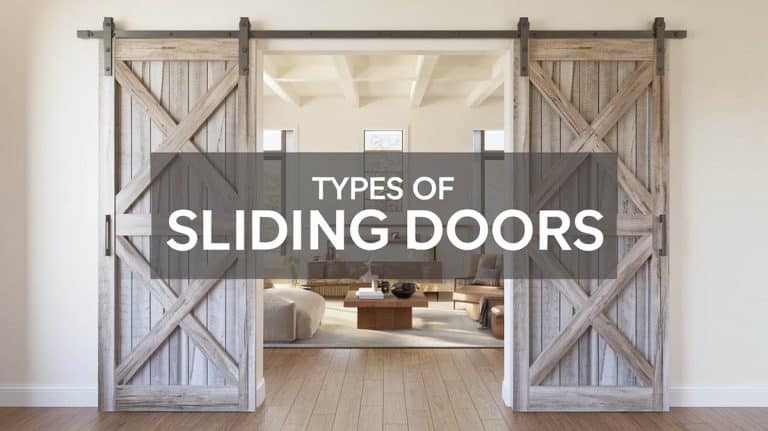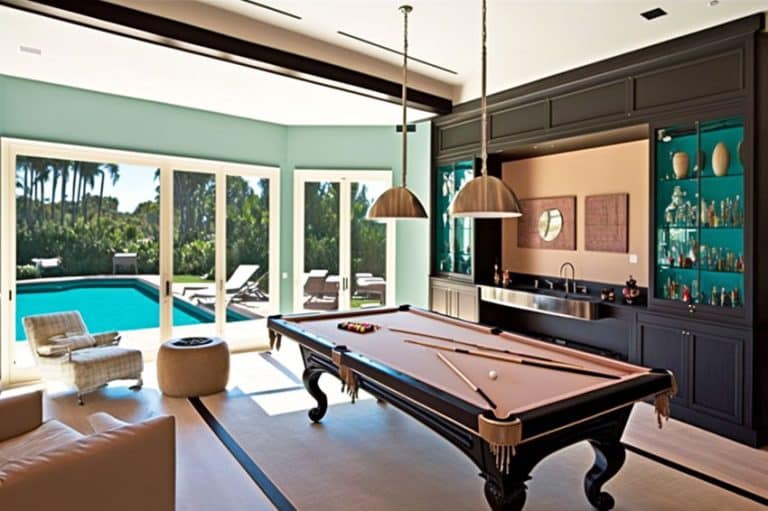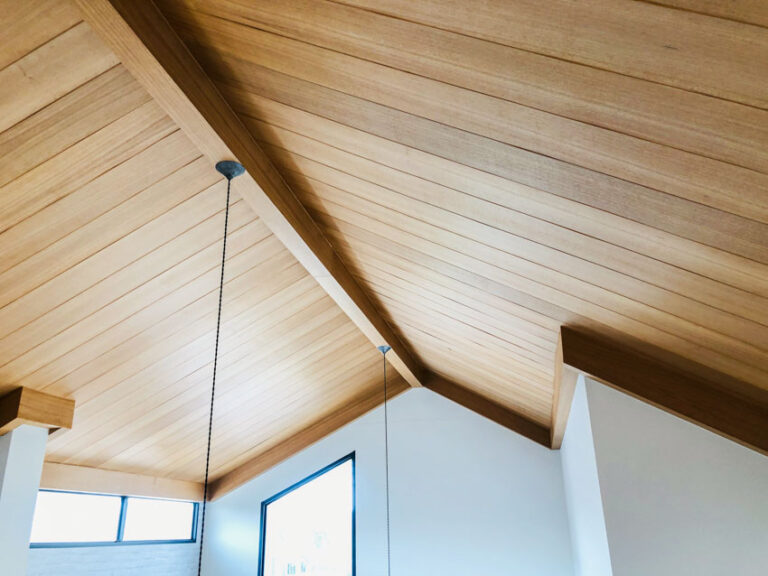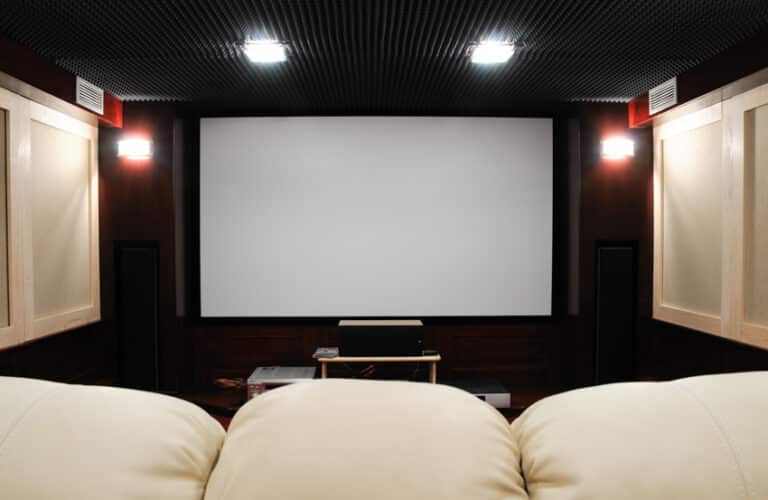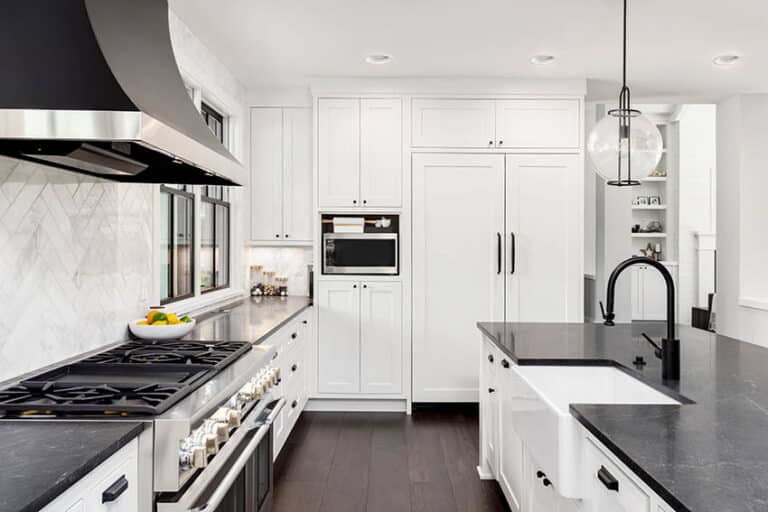11 Colors That Go Beautifully With Purple (Hue Matching Guide)

Decorating with purple is at once perplexing and enjoyable. It may not be the most popular choice, but it certainly is the most interesting. The gentle color has also proven versatile, especially in interior design. Purple is not just one color; it is a variety of shades and tones that can create a wide range of designs. When paired with certain colors, purple can create feelings and aesthetics that promote actions or suggest who uses the space or why it is used. Be sure you are using the right color combinations as well as the type of purple you use to create the intended look.
Purple walls make perfect backdrops and bring a sense of grandeur to a room. You can paint one side of the wall purple to highlight a particular niche. It also works best with accent decors and centerpiece furniture like the sofa or bed. If you want to know how you can pull off this lush and attractive color to your interiors, we have the easiest matching guide for you!
Purple combines the intensity of red and the stability of blue. This attractive color is best known to mean luxury, royalty, and ambition, but it can also represent wisdom, creativity, devotion, independence, and dignity. However, some find the color too foreign or often associate it with mysticism and darkness. Many think of it as too bold or too difficult to pair with other colors. But nothing could be further from the truth!
Just like any shade, purple is fun to experiment with, and there are tons of ways you can use it in your home. Understanding color theory can help you find the perfect combinations to use with these hues.
What Color Goes Best With Purple?
Purple is a pretty versatile color with no single match for it. Generally, it is best paired with orange, yellow, green, brown, black, white, and grey. But various tones of purple have their corresponding recommended color matches as well. Ultimately, these combinations would only depend on the purpose of a room or a specific style you’re going after. Now that you know the different schemes that work with purple, you can choose specific hues to convey a certain aesthetic in your home. Below are the most common designer-approved matching hues for your interiors.
Colors That Go With Light Purple
Light purple is often called lilac or lavender, and even periwinkle. The lighter values of the shade add a restful mood to a room.
Orange
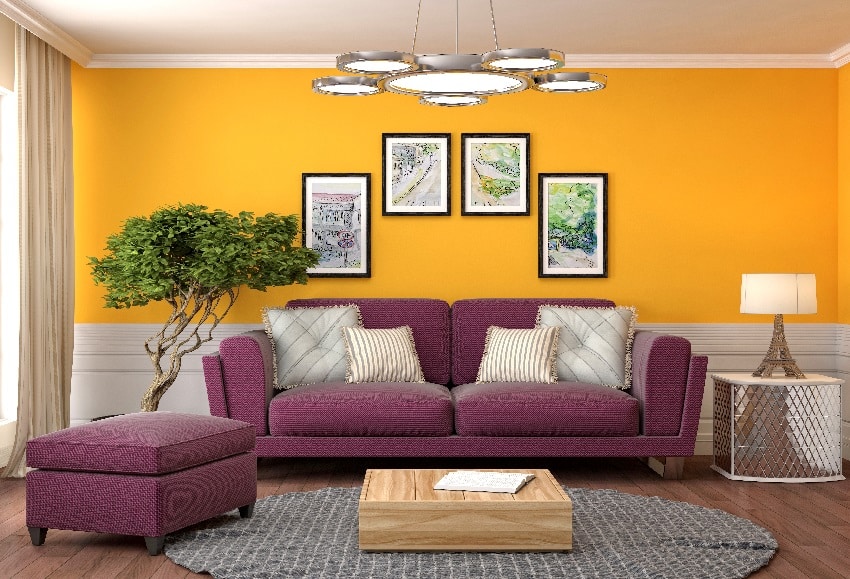
Everybody knows opposites attract, but purple and orange are the best examples of this color theory. The energizing orange is tamed with a calm grape hue and, thus, creates a perfect visual balance. If you want a room with a vibrant character, this paint scheme is for you.
Green
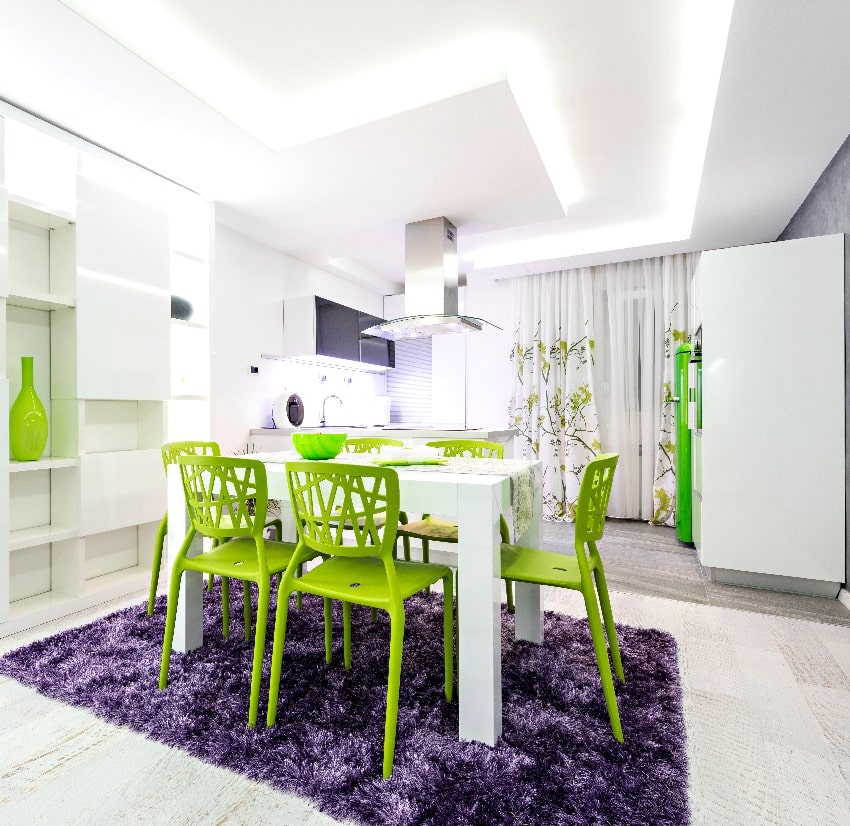
It may seem like a surprising contrast, but different shades of green – especially lime, olive, and mint green – have long been the perfect pairs for purple interiors. This classic combination is best mixed with white or light beige to make the room feel more natural to look at.
Colors To Use With Dark Purple
Purple, in its darkest value, makes an elegant partner to gold, silver, and other metallics, giving your home a sophisticated appearance.
Mustard
Just like green, yellow is another complementary shade of purple, and you’ll find the two naturally balance out. You can make the room appear livelier and more interesting by pairing dark purple with a darker yellow shade, which is mustard.
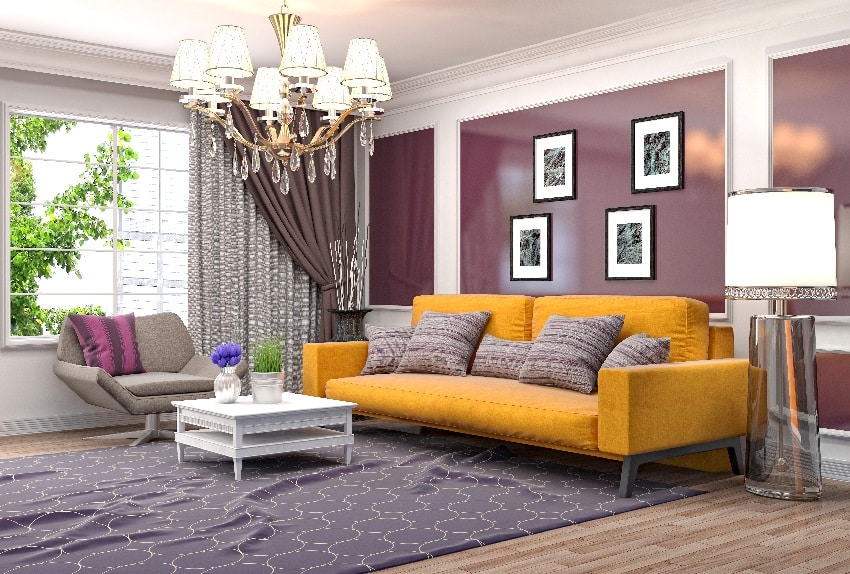
While a fashionista’s favorite, this plum and mustard combination is also well-loved by interior designers to bring a vigorous yet sophisticated ambiance to a room.
Brown
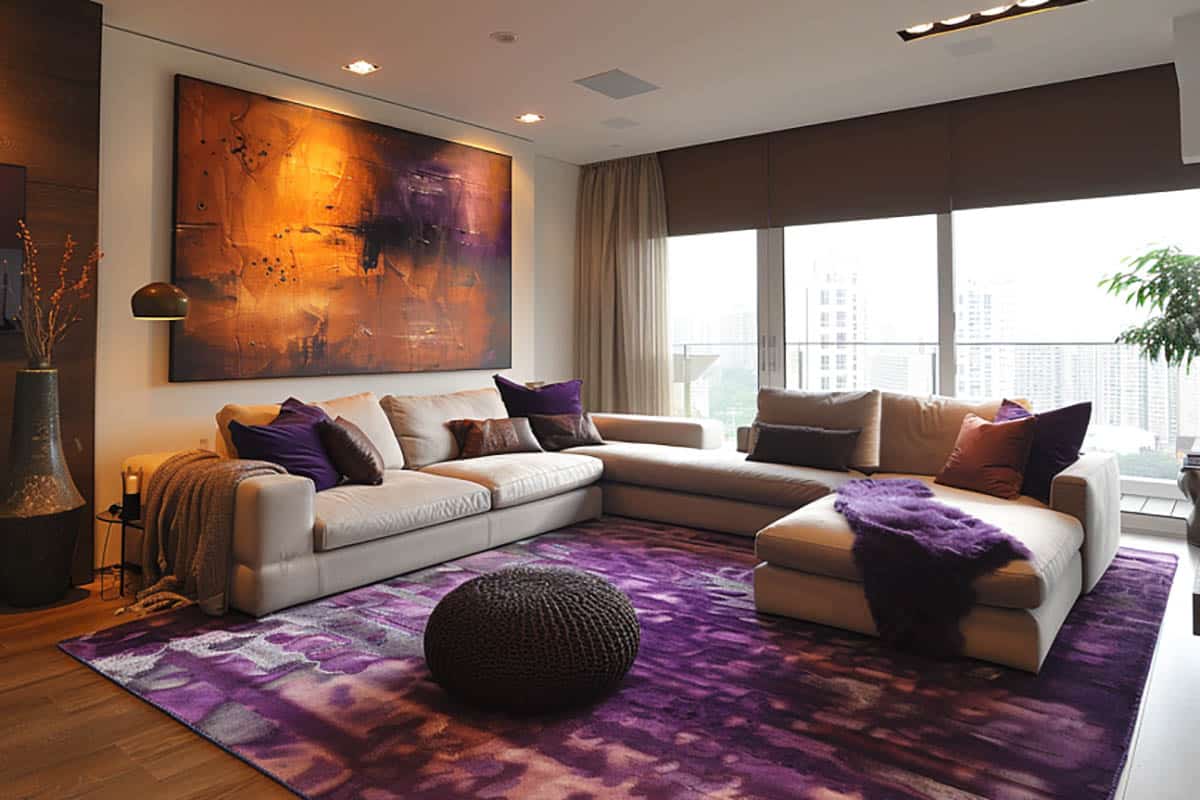
If you don’t find contrasts to your taste, neutrals like brown, coffee, tan, and beige are wonderful color matches for dark purple, too. You can use these shades for upholstery, rugs, and other textured surfaces, which perfectly blend with a dark hued backdrop – a great idea for a cozy study!
Old Rose
Darker tones of purple combined with a soft, dusty-pink shade create a cool and cohesive ambiance, as most monochromatic color schemes do.
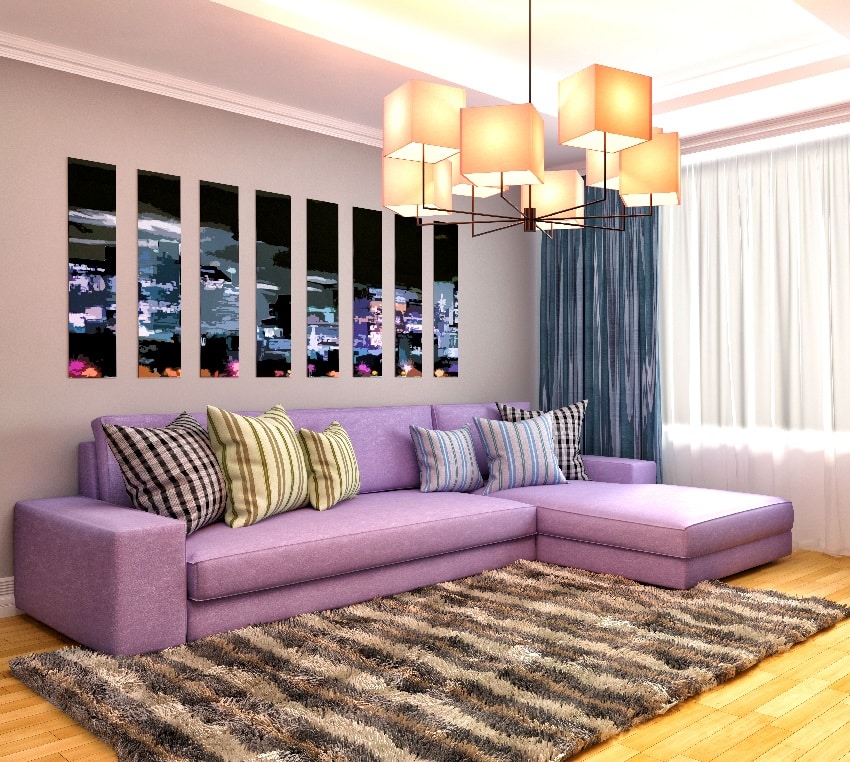
With this combo, dark lavender works best as touches and details, such as rugs, upholstery, or accent furniture. It would look more special and become a point of interest in an otherwise neutral palette.
Colors to Combine With Pastel Purple
Pastel purple is a less intense but much sweeter shade of the luxurious hue. It creates a light and soothing atmosphere and is great for any room.
Taupe
Muted pastels always work well with neutrals; the same is true for pastel purple. Taupe blends grey and brown and is the perfect alternative to commonly used neutrals like black, white, or grey.
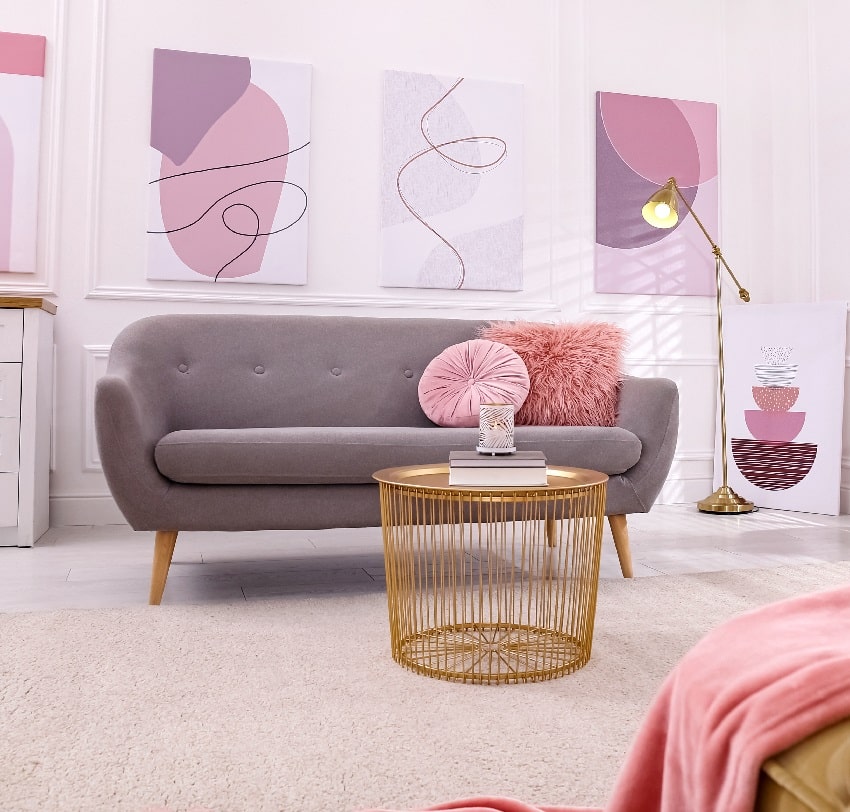
Combined with pastel lilac, it creates a two-toned casual and airy space without looking plain. Other hues, such as periwinkle, iris, orchid, amethyst, and lavender, can offer similar outcomes with different undertones.
Purple and Blue
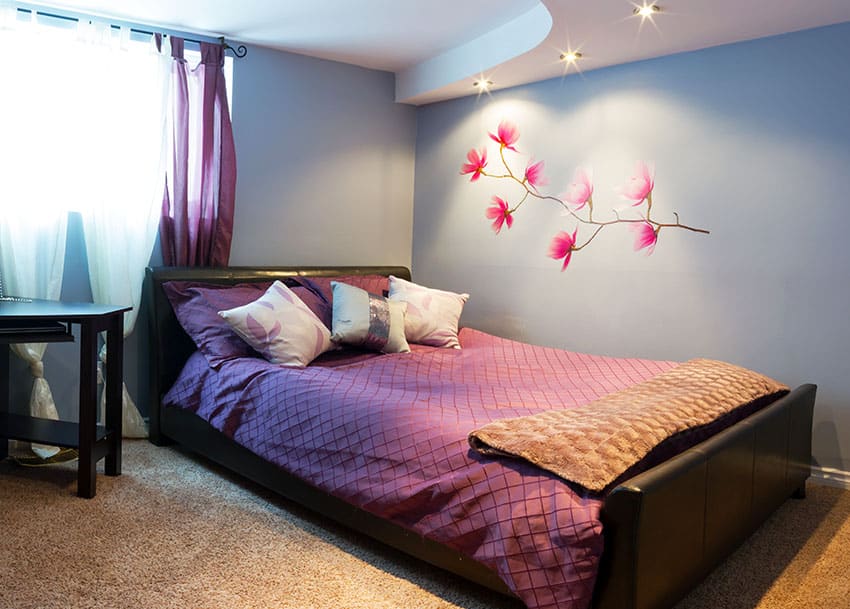
Purple and blue are a great combination that keeps a calm and cool aesthetic. Lighter shades of purples and blues can also add some light green into the mix to give a brighter, more playful look to the room.
Going with richer, darker shades of purple and blue makes the room heavier and promotes more sleep related colors in the bedroom. See more purple bedroom ideas here. Using clear or white finishes is recommended when using brighter shades, as well as light, yellower wood tones. For the darker shades silver and gray finishes along with darker or gray wood tone items compliment and accent the space.
Pastel Blue
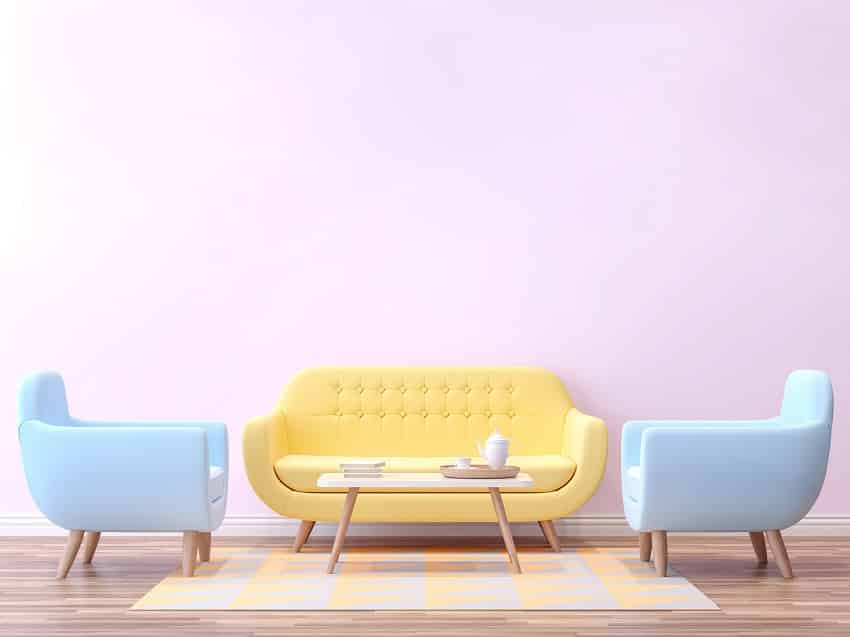
Blue and purple give away a sense of tranquility, and such becomes more defined when these colors are muted. Pastel tints of purple and blue create a soothing vibe from casual to contemporary themes. Just don’t forget to add some contrast, such as colorful decor and home accessories – so it doesn’t look too muted.
Purple and blue are a great combination that keeps a calm and cool aesthetic. Lighter shades of purples and blues can also add some light green into the mix to give a brighter, more playful look to the room. – interior designer Savannah Phillips.
Purple and Gray
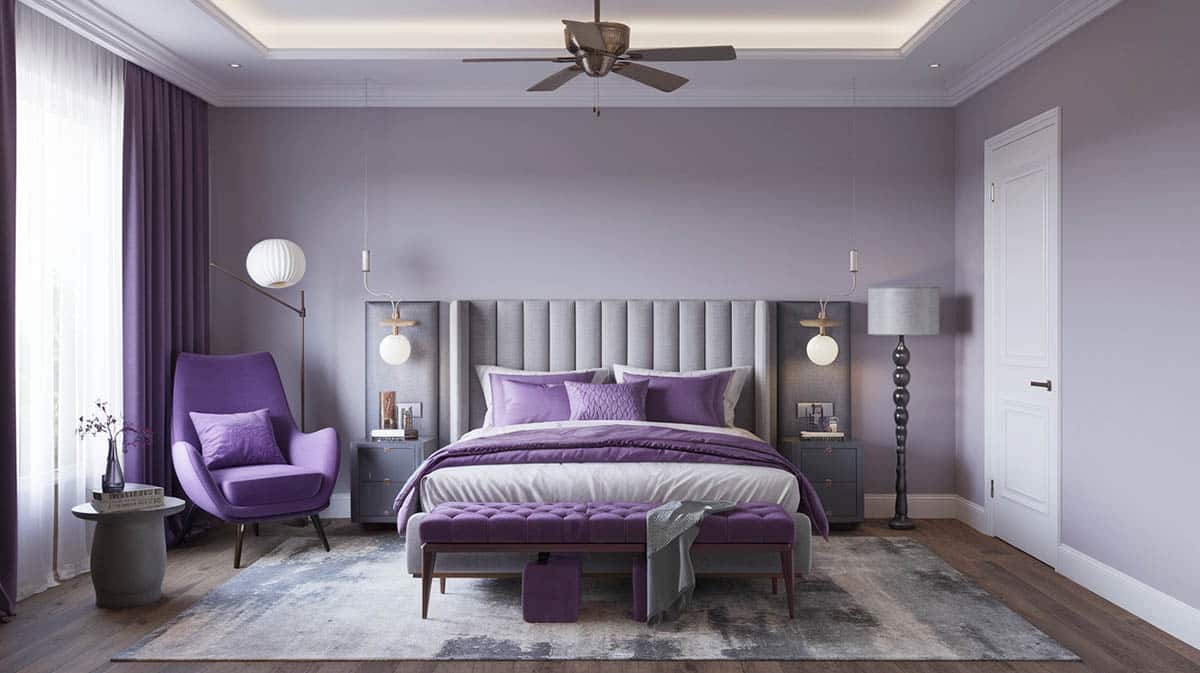
Purple does not always need to be on every object of a room to be noticed. Using purples and grays together can lead to an upscale look without an overwhelming amount of color. Pulling out the cooler tones of both the purple and the grays gives a sophisticated and complete look. Multiple shades of gray are recommended so as to not leave the space on one note.
Incorporating black also gives a sleek look to the space, as well as mirrored surfaces. That being said, for those purple enthusiasts, purple can be the main color, using many different shades, hues, and tones, while using gray as an accent to tie the space together. Both mentioned color combinations pair well with silver or black finishes. Pulling in cooler, darker wood tones or gray wood tones can also tie the space together.
Purple and Pink
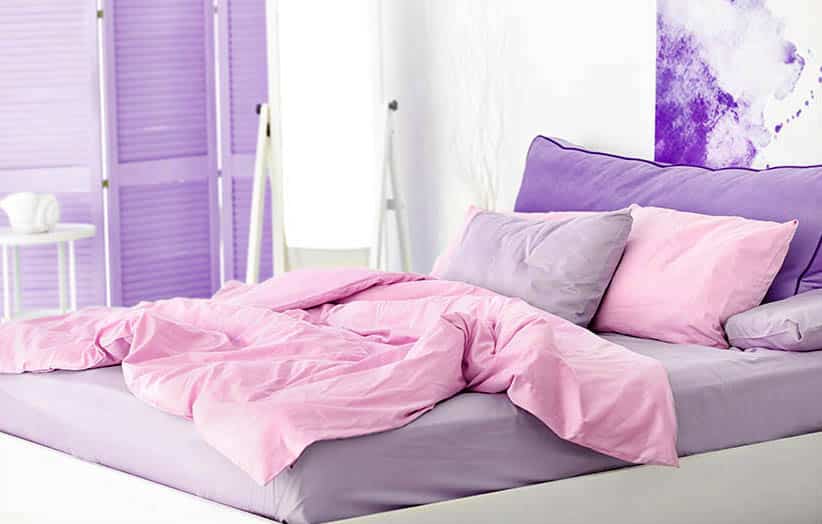
Purple and pink are somewhat of an iconic duo, often being the first pairing you think of when purple comes to mind. The combination can also include some oranges when trying to keep a bright and playful palette. These colors give an extremely energetic and loud visual. Using darker pinks and purples can tone down the energy a little if there is fear of overwhelming the space, which can be common with this color combination. Using bright pinks and purples screams enthusiasm and will need a good neutral, commonly black, to bring the space together and add some structure.
When mixing deeper shades of purples of pink, you can throw in some reds to give a romantic or intimate feel to the space. The lighter shades of this color combination goes well with clear finishes and lighter, warmer wood tones. The darker shades can become extremely powerful with black or white finishes, and dark espresso colored woods.
Purple and Yellow
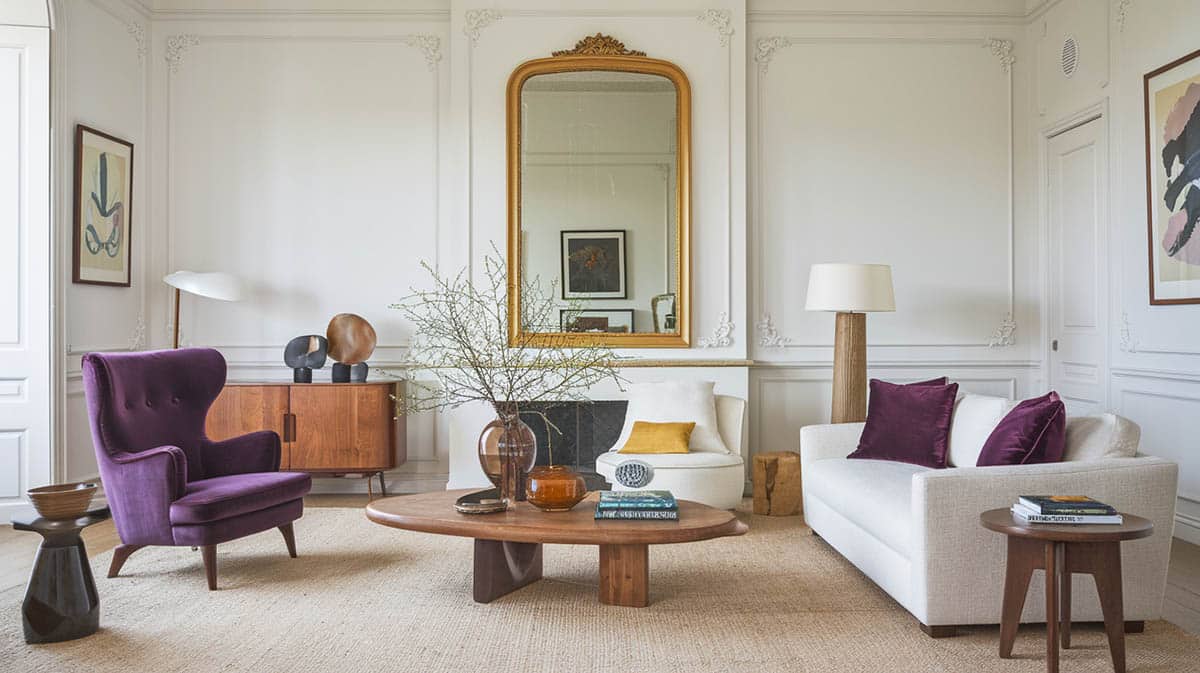
While most may not initially think to pair the colors yellow and purple, they are complementary colors, meaning they are opposites. Complimentary colors are extremely appealing to the eyes, and these are no exception. Selecting one of the two as a main color and the other as an accent is the best way to start. In the idea that yellow is the main color, white creams, and lighter-colored wood tones are recommended to bring out the warmer tones of the space. Then the purple accents would be brought in to cool it down and offer contrast to the space.
In the matter that purple is the main color, with the intent of cooler space, darker woods, and black finishes are recommended. Throwing in some white finishes with yellow accents brightens the room and adds interest to the space.
Purple and Beige

For a soft, inviting and neutral space, purple paired with beige is a must. Using pale purple accents and furniture pieces in a mainly beige or taupe room gives a relaxing feel to a bedroom or living room.
It is best to use purple sparingly, but it could be any color purple on the spectrum, as the color gets darker, the heavier the room will get, the lighter shades give the illusion of a light and a softer space. – interior designer Savannah.
Multiple shades of the color and the neutral are welcome to help give the space dimension without adding too many colors and taking away from the simplicity of the overall space. These are best paired with warmer, medium tone woods as well as white, beige, or wood tone finishes.
Best Color Combinations with Purple
We spoke with interior designer Danielle Porter about how she goes about finding color combinations that go with purple , and here is what she had to say:
Purple is a versatile color that can add a touch of both sophistication and elegance to any home. Integrating this hue into your home can add depth and warmth to any room, whether you want to create a bold statement or a subtle accent.
To ensure a cohesive color palette and design, it’s important to pair purple with the right palette and on the right pieces. We’ve put together a guide below to help you seamlessly integrate the shade into your home through your home decor, paint, and accents.
Idea 1: Start with a Neutral Base
If purple isn’t intended to be the feature in your space, we recommend starting by selecting a neutral base. Neutral shades like white, beige, or gray provide a clean and simple backdrop for the purple accents to stand out.
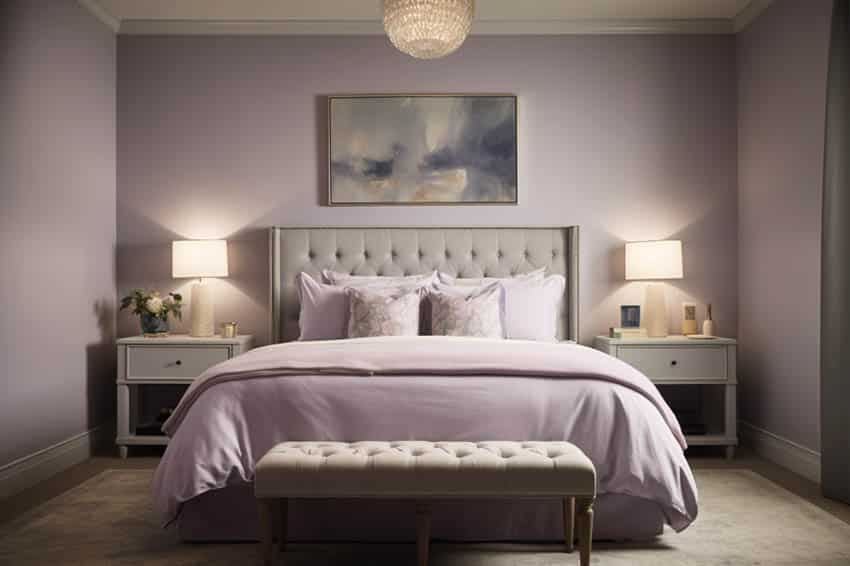
Darker shades will make a bold statement without overwhelming the space, and lighter tones will feel like a softer integration into it. The bonus of this approach is that neutral walls, flooring, and furniture will also allow you to change up your decor more easily without the need to overhaul the room completely.
Idea 2: Pair Purple with Complementary Colors
When it comes to color matching, complementary shades can work wonders. If you need guidance here, check out the color wheel; essentially, any colors that are opposite one another are considered complementary.
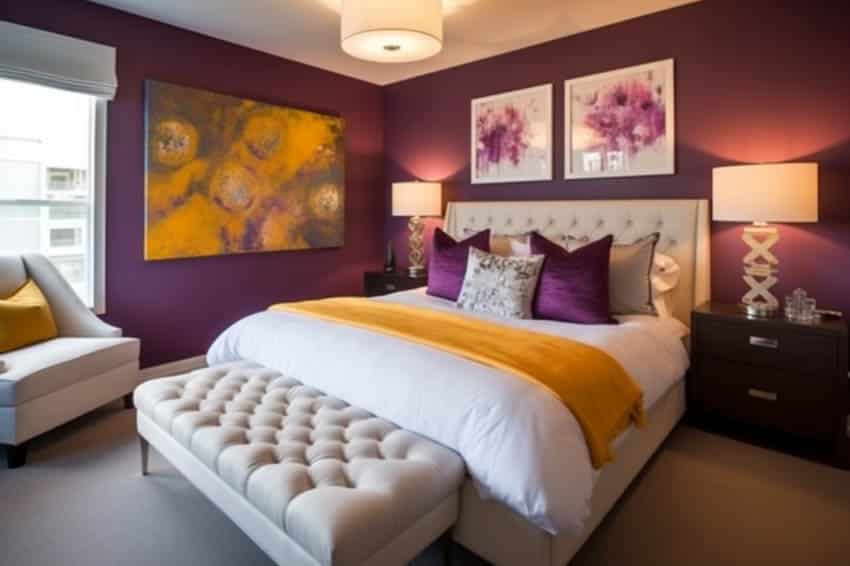
Pairing purple with complementary colors like green, yellow, and orange can add a pop of energy and interest to your space. For example, a purple sofa can be paired with green pillows, or purple curtains can be paired with yellow accents in the hardware and details.
Bringing in hues that work together will naturally create a layered space that is inviting and full of life.
Idea 3: Mix and Match with Other Purple Tones
Another great way to integrate purple into your home is by mixing and matching different shades of the hue.
For example, a light lavender wall can be paired with a deep plum rug or throw blanket. Bringing in multiple shades will add depth and interest in the space.
The natural complexity that this method creates will give you an end result that is both coordinated and sophisticated.
Idea 4: Test a Few Textures
To add even more interest to your decor, experiment with different textures. Just as multiple tones can bring in a natural depth and interest, having multiple textures creates a unique visual and tactile experience – making the space feel more intriguing.
Silk curtains, a velvet armchair, or a sleek vase in purple can add a variety of textures to your space, making it feel more dynamic and inviting.
With this approach, we always recommend playing with the textures of all the colors in your space – let the textural difference be the feature!
Idea 5: Use Purple as a Statement Piece
If you’re really looking to make a splash – consider using purple as your focal point or statement piece. Whether it’s an accent wall, a sofa, or a piece of art, boldly using this color can create an impactful aesthetic that your guests won’t soon forget.
The key is to balance the statement piece with more subtle accents so the hue doesn’t overwhelm the space. Pairing a purple sofa with neutral pillows and a white coffee table, for example, can create a sophisticated and balanced look.
As you can see, whether through a subtle accent or a bold statement, integrating purple into your home can be done successfully in various ways.
Purple can bring excitement, softness, depth, and warmth to any space, and these color-matching tips will help you create a cohesive and inviting space that reflects your unique style.
Colors That Match With Purple
To understand color theory, all you need is a color wheel so you can easily gauge which shades are harmonious with each other and which ones are best paired with purple.
Complementary Colors
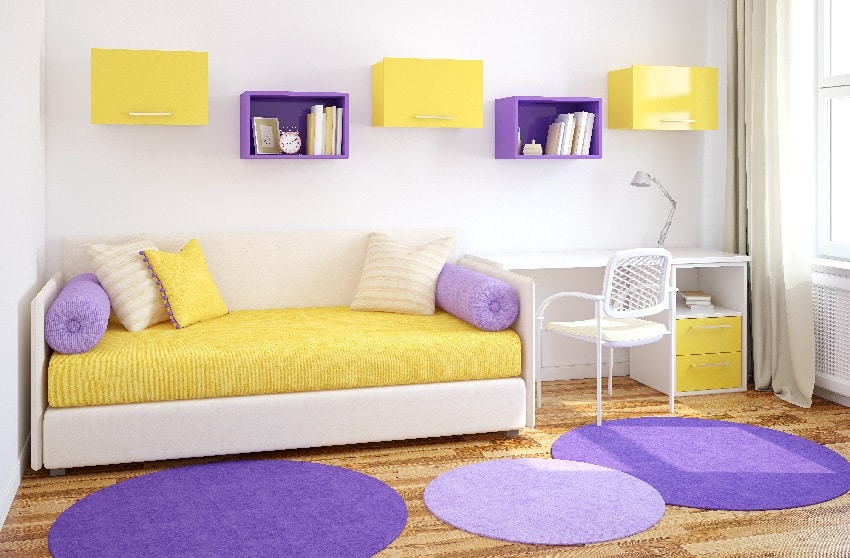
This purple bedroom design features a complementary color scheme. Colors that are directly opposite each other are called complementary colors. They contrast each other and create a balanced visual effect. For purple, the complementary hues are green and yellow.
Analogous Colors
Colors that are positioned beside each other are called Analogous colors. This color scheme is most harmonious since it is often found in nature. The colors analogous to Purple are the ones sitting right next to it in the color wheel, either from the left or right. You can use purple as the main color and secondary colors as accents.
Triadic Colors
Another color scheme you can try is the Triadic color scheme. For this, you select three shades that form a triangle in the color wheel. For a triad with purple, you get orange and green. This combination brings a more energetic vibe when used in a room.
Monochromatic Colors
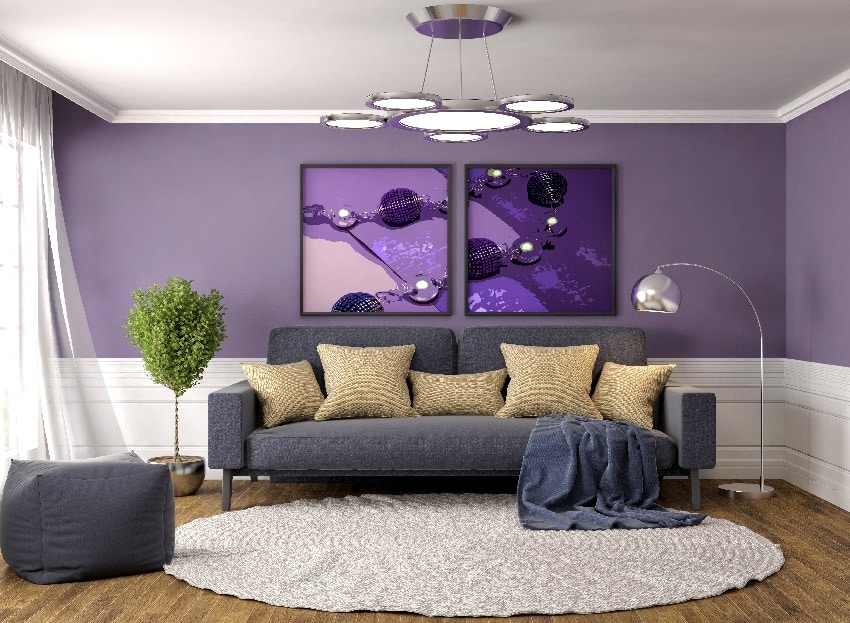
If you want to stick with just purple, you can always play with its various shades and tints. This is called the Monochromatic color scheme and is achieved by adding black or white to the base shade. A mauve wall with white wainscoting pairing can balance the room and look refreshing and lively.
A monochromatic purple color-scheme goes well with neutrals, such as grey, brown, black, and white.

